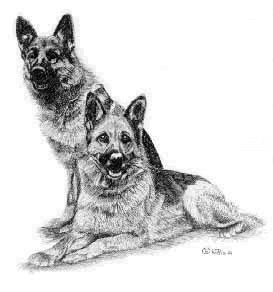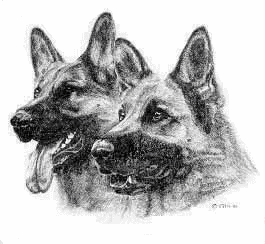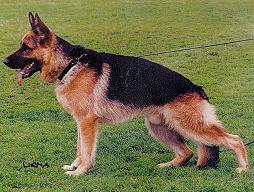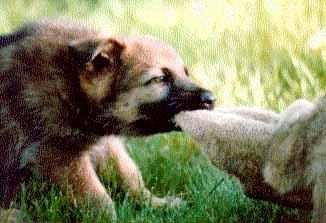I believe my respect for the courage and loyalty of the working class GSD is evident. I hope I was able to instill some of this respect in the audience during the oral presentation and in readers of this report.
Sincerely,
Charles A. Joseph
TITLE PAGE

Picture Courtesy: Leerburg Video Productons
AN INFORMATIVE REPORT ON THE
WORKING CLASS GERMAN SHEPHERD DOG (GSD)
(From Puppy-hood Through Training)
by: Charles A. Joseph
GSD Owner and Aspiring Handler
Date submitted: Dec. 1996
TABLE OF CONTENTS
| SUMMARY | iii |
| INTRODUCTION | 1 |
| DISCUSSION | 1 |
| Show Class - Working Class Differences | 2 |
| Selecting A Puppy | 3 |
| You Have Your Puppy - Now What? | 3 |
| Prey Drive | 4 |
| Defensive Drive | 4 |
| Drive Interaction | 4 |
| Training Sequence | 6 |
| Commitment | 7 |
| CONCLUSIONS AND RECOMMENDATIONS | 7 |
| WORKS CITED | 8 |
| APPENDIX | |
| Interview | a1 |
page ii
SUMMARY (abstract)
Working class German Shepherd Dogs (GSD) differ from show class dogs in appearance, temperament, amount and level of drives. This came about through selective breeding by breeders and organizations looking for specific attributes in their animals. The drives inherent in working class GSDs allow them to be trained for sport and professional activities such as Search and Rescue or Police Service Work. Choosing a puppy with the correct drives is the essential first step in developing a working class GSD. This is followed by a carefully orchestrated training program with clear established goals. Commitment on the part of the handler must match the commitment expected of the dog.
The controversies surrounding the different teaching methods and training sequences are on-going with strong feelings on both sides. This is unlikely to change. The dedicated handler must analyze his goals, his dogs apparent drives, consult with his
trainer and formulate their best approach to the dogs training.

Photo Courtesy: Leerburg Video Productions
iii
Page 1

picture courtesy: Leerburg Video Productions
INTRODUCTION
Many people think as I did a short time ago. A German Shepherd is a German Shepherd is a German Shepherd. That is not the case. While the German Shepherd Dog (GSD), as a breed, is included in the working dog category of canines, within the breed itself there are two classes:
1. Show Dogs
2. Working Dogs
The working dog category of canines and the GSD classification of working dogs address similar characteristics. The GSD classification, however, is more specific. It expects these characteristics, called drives, rather than merely addressing them as desirable.
Knowing this opens the larger question: How best to develop these drives and train the dog for the specific job it will perform? This discussion will focus on the key drives necessary in the working class GSD. We will examine the interrelationship of these drives. We will also see how the proper sequencing of the training affects the channeling of the drives.
DISCUSSION
There are many drives that go into the makeup of a good working class GSD, or any other dog. Drives are instinctive, a matter of genetics. A dog either has them or does not. Drives cannot be taught. They can, however, be destroyed. They can also be
distorted or channeled incorrectly. The trainer, handler or owner interested in the maximum performance of his dog will do his utmost to insure the correct channeling of the dog’s drives. This will include both proper training of the drives and the
sequence of
the training.
The key drives required in a working class GSD are:
1. Prey Drive. Page 1 Page 2
Before addressing the drives in detail, I must point out the major differences between the show class and working class GSDs.
SHOW CLASS - WORKING CLASS DIFFERENCES
The show class GSD is a product of intensive breeding by American breeders (primarily) and some European breeders. The aim was to develop and reinforce the classic characteristics of the sloping back, longer snout and slighter frame that are considered
aesthetically acceptable for American Kennel Club (AKC) shows (Photo 1). These dogs can make fine pets. However, the drives that would have made them good working dogs has been bred out of them. The few that do inherit the necessary drives usually
lose them to improper training.
The working class GSD is “boxier” in appearance, has a shorter snout, a straighter back and a more solid frame. The build serves better for the strenuous work expected of the class (Photo 2). These dogs can be expected to do well in sports such as
Schutzhund or KNPV (Koninklijke Nederlandse Politiehond
Vereniging). Schutzhund had it’s birth in Germany, while KNPV originated in Holland. My preference is KNPV as the requirements are more realistic. It is usually possible to train a KNPV dog in actual work disciplines such as Search and Rescue (SAR),
protection or police service work (Kaldeway 1). As a matter of fact, many law enforcement professionals consider Schutzhund largely “window dressing” (Lanting 49). However, it is a bona fide working dog sport with many avid enthusiasts.
Page 2 Page 3 SELECTING A PUPPY
The important first step in selecting a puppy is identifying those with the key drives. Shy dogs that look or act frightened are immediately rejected (ARDA 27). Some of the positive traits to look for are:
1. A puppy that “attacks” your pant legs.
Such puppies are exhibiting good prey drive (Frawley. drives2 1-2). It is also a good idea to observe the puppy’s parents. A good breeder will usually have them available. Examination of the puppy’s pedigree is highly recommended and will be
available for any AKC registered dog.
YOU HAVE YOUR PUPPY - NOW WHAT?
Once you’ve selected your puppy, some form of training begins almost immediately. This will be about the eighth week of his or her life. The two most important points in this area are:
1. Selecting a trainer.
Finding a trainer to work with is crucial. He or she is going to guide you and your puppy through some very critical stages. You and the trainer must agree on the approach. There is currently much
controversy in the proper methods. There are still many proponents of the old way of using negative corrections. Not only does this involve the use of harsh corrections to errors the puppy may make (Lanting 48), but often the harsh introduction of new
commands to be learned. The newer method stresses a fun-filled learning period with positive reinforcement and positive correction to errors. While I am a proponent of the newer method, it is not my intent to solve this controversy in this report.
Suffice to say, whatever the approach, you and the trainer must agree.
You must also have a goal in mind. What are you training for? Schutzhund, KNPV, SAR, Police/Protection, what? The total training evolution may be different. Some resulting responses of the dog are not interchangeable. You must establish your goals
early in the training cycle.
Page 3 Page 4 PREY DRIVE
When a dog is in prey drive certain characteristics are evident. They are:
1. The hackles (hair on the back of the neck) are NOT raised.
It is important to note the dog is in a non-stressed, happy state. Equally logical and important to remember, the dog will quit (shut-down) when it feels tired. It is not a life-threatening situation. Boredom or tiredness can overcome the drive. The
handler must be able to recognize when the dog goes in and out of the drive on its own. He must also be able to put the dog in or out of the drive.
DEFENSIVE DRIVE
Defensive drive is a life-threatening situation. Life-threatening either to itself or the handler. At least as the dog perceives it. It may not actually be life-threatening. The recognizable characteristics are:
1. The hackles are raised.
Note that in this drive the dog will not shut down because of tiredness or boredom. He or she perceives a serious threat and adrenaline takes it beyond being bored or tired.
One of the controversies surrounding these two drives is which should be trained first, or should they be trained together. To me, logic dictates a dog must be comfortable and accomplished in prey drive before defensive drive training is started. But
still the controversy rages. Ed Frawley puts it rather succinctly in the title of his on-line article, def-frst. Mr. Frawley titled this article, “Training DEFENSE before PREY is STUPID !!!!!!!!!” (1). I find his candor refreshing and his point easy
to understand.
In this article Mr. Frawley contends that each dog is an individual. While some may have similar nerves or thresholds, no two are alike. Each will have his own point in the training where defense should be introduced, but in no case should the defense
training precede the prey training (2). Considering the individuality of each dog, I am reminded of the earlier point in this discussion about finding a trainer with whom you agree. Elaborating further, it is essential that together, you work out a
program that fits your dog!
DRIVE INTERACTION
Ed Frawley says in his drives2 on-line article, “Understanding the drive interaction is an important part of all dog training” (1). Perhaps the interaction between the prey and defensive drives can be better illustrated by introducing three associated
drives in a double-decker sandwich format. (Illustration 1, next page)
Page 4 Page 5
Play drive is a direct lead-in to prey drive. It is the dogs’ drive for physical contact with pack members (Frawley. drives3 1). Remember to the dog, the handler is a pack member. The joyful exuberance of this drive flows smoothly to the
non-stressful prey drive pursuit of its job. In the wild the job would be the catching and killing of food. In our society the job will be a sport or one of the worthwhile functions we train them to perform.
Fight drive bridges the gap between prey drive and defensive drive. This level manifests itself in the dogs desire to measure its physical prowess with rivals (Frawley. drives3 1). The rivals may be pack members or outsiders. It should be noted that
the dog would likely move into defensive drive easier or more quickly with outsiders. Frawley’s definition of fight drive is “A dog that is working with the forwardness of prey and the intensity of defense” (def-frst 3).
Avoidance is the natural projection beyond the defensive drive. When the perceived threat that put the dog into defensive drive becomes so strong the dog feels he cannot win, avoidance sets in. In confident dogs with strong nerves avoidance may not
show until after fatal injuries are received. In that case the avoidance is merely a mental event. Physically it’s no longer capable of fleeing. Conversely, in dogs with weak nerves avoidance can occur early in the defensive drive, - or in severe
cases, in fight drive or even prey drive.
Understanding this is a key to understanding how much endurance to expect from a dog. (Illustration 2)
The further to the right of defensive drive that avoidance occurs, the more endurance, (drive to stick to the job at hand), the dog possesses. To illustrate the importance of this concept, consider the following SAR scenario.
A real search mission has been in progress for several hours. The weather is bad, humans and dogs are tired. The dog does not know this is for real. He has been on many practice missions in the past year. To him this is just one more. It started out
as fun, but now he’s tired and worn out. He’s ready to quit. Remember, he’s been working in prey drive. But you, the handler, the human, know this one is for real. You know 90% of the area has been covered. Another hour or two will find the lost
person who
desperately needs help. You’ve got to keep this dog going. You must:
1. Know the point each drive kicks in and how to get the dog to that point.
How do you do this? You can, if you:
1. Selected a dog with the right drives during your puppy selection.
If the preceding steps were followed faithfully, such a scenario is far more likely to have a happy ending.
Page 5 Page 6 TRAINING SEQUENCE
Thus far we’ve discussed the differences between the GSD show and working classes. We’ve addressed the necessary characteristic drives required in a working class GSD. We’ve addressed the selection of a puppy, then jumped ahead to the expected
results (goals). This was intentional. Earlier in the report I stressed the handler must set the goals early in the training cycle. We did that. Now, how and in what sequence will the training be accomplished?
In addition to his or her job training, a working GSD requires obedience training. Actually, I recommend obedience training for all dogs, including pets. Obedience training consists of the following basic commands:
Come
Other commands, such as Finish Heel, Stand, Go and others may be added at different training facilities. Basic obedience consists of working on leash, while Advanced works off leash. Silent commands are introduced in Basic and applied in depth at
Advanced. Some facilities break the training into three levels. The exact breakdown is less important than the dog learning the basic commands and learning to execute them on your command. Immediately! An important point in the teaching of silent
commands is for the dog to learn to focus on you, the handler. In some working situations that can be crucial.
For working dogs that may be in the public eye, obedience training is a must! The image of a working dog misbehaving during lulls in work or practice sessions is unthinkable. Regardless of how well the dog can perform his job, displaying a lack of
discipline would destroy the public confidence trainers and handlers have worked so hard to build. Additionally, the disciplines learned in both task and obedience training are complementary. Done right, each reinforces the other. In their book
“Search and Rescue Dogs”, the American Rescue Dog Association makes it clear that they feel a SAR dog without obedience training simply will not work (78).
There are different schools of thought regarding the sequence of training. Training in general and specifically in the sequence of task and obedience training. Some say:
Obedience training first.
To some degree, all are right, if you accept the modern concept outlined by Tom Rose and Gary Patterson in their book, “Training The Competitive Working Dog” (44). The concept, called “imprinting”, is based on three suppositions.
1. The puppy is genetically inclined to do the task which lies ahead and the handler has been careful in selecting a puppy with the necessary genetic make-up. (Has the drives).
Page 6 Page 7
Through gentle teaching and positive correction, puppies are taught to want to do the things you want them to do. The sessions are kept short and pleasant and should always end on a happy note. The puppy should be left wanting a little more, rather
than be allowed to shut down from tiredness. Boredom must never be allowed to set in. It amounts to a sort of kindergarten. The dangers of harsh or negative corrections are obvious. If the puppy perceives some of these activities are associated with
unpleasant
or painful things, he will not learn. Not even try. All the anger in the world will not get through to him. He will not and can not learn tasks or obedience through fear. He will fear the learning and therefore, not learn anything but that fear.
(Proponents of the old methods - can you hear me screaming?!!)
The positive correction learning sessions gradually expand in time as the puppy grows and learns to control his drives within the context of what you want. His confidence, which if you chose well was already high, will grow as he learns to please you
and realizes that he has. His confidence in your judgment (as his pack leader) will grow and solidify.
At about the eighth month he will be ready for the structured environment of obedience classes and basic training for his future job. He or she will be able to approach these new experiences confident that you are not leading him (or her) into a place
or situation to fear. By the time this stage of training is over you
and he are ready to attack the more intensive training for his job. He now respects you, not only as his leader, but as a partner and companion. You have shared his learning experiences. He knows you will share whatever lies ahead. He wants to please
you. You are the most important focus in his life. If the puppy was chosen well and the training handled properly, that IS the way it will be. And if that is the way it is, he will react to your commands instinctively and instantly (qtd. Hubbard, see
appendix a1).
COMMITMENT
My final point is commitment. You have taken the dog through some very intensive training. He will do anything in his power for you. Do you share this commitment? The training is never-ending. To keep a razor sharp it must be honed almost daily.
The same is true for the team that is you and your dog. To stay sharp, you must work hard. Continually! If you are not ready or able to make such a commitment, don’t even start. Get a pet dog. They too, require patience, love and commitment, but not
to the degree of a working dog.
CONCLUSIONS and RECOMMENDATIONS
If you really have the desire to become a handler and develop a working class GSD to his fullest potential, you must:
Select the right puppy.
The emotional satisfaction of watching your working class GSD do his thing is truly beyond measure!
Page 7 To Works Cited and Interview (appendix 1)
Background music for all report pages is SCHUTZEN
2. Defense Drive.
Prey drive is the working mode for most working class dog functions (Frawley. def-frst 2). The obvious exceptions are protection trained dogs and police service dogs. While their initial work may be in prey drive, they must “kick in” to defense
drive in critical situations. The interrelationship of these two drives must be addressed and is one of the principal aims of this discussion.

Photo 1: Sensen Mann Daska.
Finnish GSD Club
Internet public domain.
Photo 2: Chucho v. Schloss
Guttenburg
SCHIII KKla
Courtesy: Leerburg Video Productions
2. A puppy that sinks his little, needle-like baby teeth into your hand when you try to pet him.
(Remember, it has not yet learned to control the bite).
3. Takes an active interest in tug-of-war games or ball games. (Photos 3 & 4)

Photo 3 Courtesy: Leerburg Video Productions
Photo 4 Courtesy: Leerburg Video productions
2. Setting your goals.
2. The tail is relatively high and wagging happily.
3. The bark is high pitched and sounds happy.
2. The tail is low and wagging slowly - menacingly.
3. The dog is snarling and growling.
4. The bark is low and guttural.
SANDWICH THEORY
PLAY DRIVE = (bread)
PREY DRIVE = (meat)
FIGHT DRIVE = (bread)
DEFENSIVE DRIVE = (meat)
AVOIDANCE = (bread)
Illustration 1
PLAY PREY FIGHT DEFENSE AVOIDANCE
Illustration 2
2. Know where the avoidance point is with this dog.
3. Know how to get his adrenaline going without creating a dangerous situation.
2. Trained the dog to channel his drives properly. From the beginning of his training!
3. Trained the dog to react instinctively and immediately to handler commands (qtd. Hubbard, see appendix a1).
Sit
Down
Stay
Heel
Task or job training first.
Start early (about 8th week).
Start late (about 8th month).
2. The age of the puppy. (Six to sixteen weeks).
3. The puppy is NOT taught in a structured environment.
The first two points were pretty well covered earlier in the discussion. There isn’t much to add except to note the age span in point 2 is the most impressionable period in a puppies life. Thus the name, imprinting.
Select the right trainer.
Establish clear goals.
Patiently guide the puppy through the imprinting stage.
Seriously work with the puppy through the training stages and his adolescence.
Maintain the commitment throughout the dogs working life.
A Story For Our Time
A Tale of Courage and Grit ~ With a Twist

A Rousing Adventure
Available Now! visitors since 6 April, 1998
visitors since 6 April, 1998
Main Site counter on Home Page
Last Update: 10/19/03
Web Author: Charlie Joseph
Copyright ©2003 by Patuxent Communications - ALL RIGHTS RESERVED




